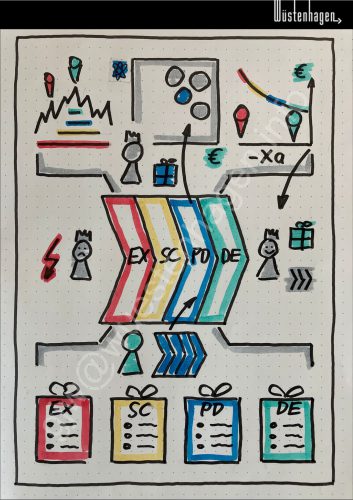Projektmanagement@GJW
DE
PM als Teil des IMP
Warum: Die zwei Liefergegenstände des Projektes erkennen und berücksichtigen.
.
Wie: Im >Definieren< das aktuelle Projekt im IMP verorten und Ausgangssituation für das Problem beziehungsweise Liefergegenstand des Projektes im Rahmen der IMP Phase beschreiben.
.
Was: Die Prozesslandkarte bei zahlreichen Unternehmen folgt dem St. Gallener Prozessmodell mit:
- Geschäftsprozessen
- Managementprozessen
- Unterstützungsprozessen
Die Geschäftsprozessen stellen unter anderem die Bereitstellung des Liefergegenstandes für den Endkunden sicher. Alles beginnt bei dem Bedarf des Endkunden ein Problem zu beseitigen. Dies geschieht über den Innovations-Management-Prozess:
- Exploration zum Weiten des Lösungsraums (Longlist)
- Scoping zum Eingrenzen auf vielversprechende Lösungen mit Alleinstellungsmerkmalen (Shortlist)
- Predevelopment als Machbarkeitsnachweis für die Lösung
- Development zum Industrialisieren der Lösung
Als Unterstützungsprozess liefert das Projektmanagement je Phase des Innovations-Management-Prozesses die erforderlichen Liefergegenstände (Liefergegenstand für den Endkunden), um den nächsten Schritt vorzubereiten und zu entscheiden. An den Meilensteinen stehen durch den Anwender des Projektergebnisses eine Entscheidung über das weitere Vorgehen zum Thema an.
Als Managementprozess liefert das Produkt-Portfolio-Management eine Übersicht aller Themen in der Pipeline, die technologische Attraktivität (Alleinstellungsmerkmal) und den erwarteten Geschäfts-Impact. Da sich nicht alle Themen realisieren lassen, ist es erforderlich zu Beginn der Pipeline weit mehr Geschäfts-Impact zu verfolgen als für den Erfolg des Unternehmens erforderlich ist. Je dichter die Realisierung des einzelnen Themas kommt desto genauer lässt sich der Geschäfts-Impact vorhersagen. Für das Portfolio-Management liefert das Projektmanagement die erforderlichen Grundlagen (Liefergegenstand für das Portfoliomanagement).
Projekte weiter vorne im Innovations-Trichter nutzen zahlreiche Prozess-Bausteine, die zuverlässig ein spezifisches Teil-Projektergebnis liefern. Weiter hinten im Innovations-Trichter kann die Anwender-Rolle auf einen tatsächlichen Nutzer eines Produktes oder Prozesses wechseln. Es kann im Innovationstrichter Projekte geben, die zwar auf den nächsten Meilenstein ausgerichtet sind und deren CTQ sich auf das Projektergebnis an diesem Meilenstein beziehen, dennoch durch Anforderungen aus möglichen Projekten tiefer im Innovationstrichter beeinflusst werden.
Der Abbruch eines Projektes sollten durchaus immer wieder erwogen werden. Zum Beispiel an einem Meilenstein des Innovationstrichters oder auch nach dem Definieren und/oder Planen zum nächsten Meilenstein. Hier werden die Beteiligten oft von dem Sunk cost fallacy verführt: Nur, weil bereits viele Mittel aufgewendet wurden, sollten nicht noch mehr Mittel aufgewendet werden.
Die Projektleitung liefert der Rolle Portfoliomanagement die erforderlichen Daten, um über Abbruch oder Fortsetzen des Themas zu entscheiden. Auch sollte der Projektleitung in diesem Zusammenhang bewusst sein, dass im Rahmen des Portfoliomanagements zahlreiche Projekte durchgeführt werden, um Themen qualifiziert zu beenden. Die wenigen Projekt-Themen, die bis zur Marktreife verfolgt werden, müssen dementsprechend ein finanziellen Nutzen haben, der weit über das einzelne Projekt hinausgeht. Projekte, deren Wirtschaftlichkeit sich nur mit spitzem Bleistift ermitteln lässt, lohnen sicherlich im Projektportfolio nicht.
EN
PM as part of IMP
Why: Identify and consider the two deliverables of the project.
.
How: In >Define<, locate the current project in the IMP and describe the initial situation for the problem or deliverable of the project within the framework of the IMP phase.
.
What: The process map at many companies follows the St. Gallen process model with:
- Business processes
- Management processes
- Support processes
The business processes ensure, among other things, the provision of the deliverable for the end customer. Everything starts with the end customer’s need to solve a problem. This is done via the innovation management process:
- Exploration to expand the solution space (longlist)
- Scoping to narrow down to promising solutions with unique selling points (shortlist)
- Predevelopment as proof of feasibility for the solution
- Development to industrialize the solution
As a support process, project management provides the required deliverables (deliverable for the end customer) for each phase of the innovation management process in order to prepare and decide on the next step. At the milestones, the user of the project result has to decide on how to proceed with the topic.
As a management process, product portfolio management provides an overview of all topics in the pipeline, the technological attractiveness (unique selling point) and the expected business impact. Since not all topics can be realized, it is necessary to pursue far more business impact at the beginning of the pipeline than is necessary for the success of the company. The closer the realization of the individual topic comes, the more accurately the business impact can be predicted. Project management provides the necessary foundations for portfolio management (deliverable for portfolio management).
Projects further up the innovation funnel use numerous process modules that reliably deliver a specific partial project result. Further down the innovation funnel, the user role can change to an actual user of a product or process. There can be projects in the innovation funnel that are geared towards the next milestone and whose CTQ relates to the project result at this milestone, but are nevertheless influenced by requirements from possible projects further down the innovation funnel.
The termination of a project should definitely be considered again and again. For example, at a milestone in the innovation funnel or after defining and/or planning the next milestone. Here, those involved are often seduced by the sunk cost fallacy: just because a lot of resources have already been spent, no more resources should be spent.
The project management provides the portfolio management role with the necessary data to decide whether to terminate or continue the topic. In this context, the project management should also be aware that numerous projects are carried out as part of portfolio management in order to bring topics to a qualified conclusion. The few project topics that are pursued until they are ready for the market must therefore have a financial benefit that goes far beyond the individual project. Projects whose profitability can only be determined with a sharp pencil are certainly not worthwhile in the project portfolio.
Geplante/Erforderliche Verbesserungen
tbd
